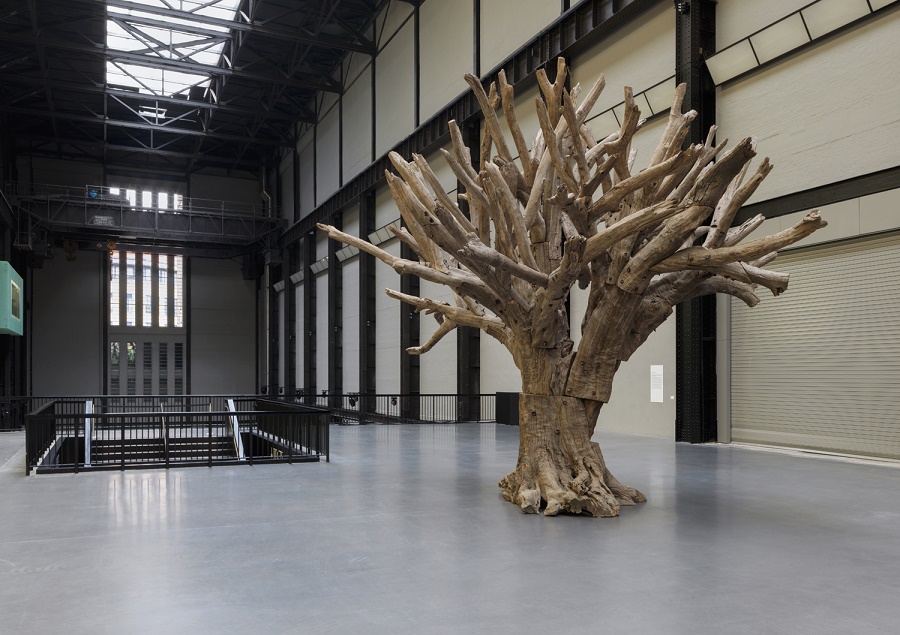Here comes the Switch House. The 10-story new build attached to the Gilbert Scott Bankside power station that was the first instalment of Tate Modern in 2000 opened to the public this weekend. Tate Modern’s expansion became almost a necessity as the original estimate of two million annual visitors became five million. Designed by the Basel-based duo of Herzog and de Meuron, also responsible for the original Tate Modern, it is an astonishing building which is intended, much more overtly than its mother gallery, to change the ways in which the public approaches and understands contemporary art.
Tate Modern argues that it is already worth £100 million annually to London in employment, tourism and the rejuvenation of Southwark, once one of London’s poorest boroughs. So the £230 million from public and private sources which the new building has cost will soon seem to be as nothing. It is also deliberately embodies a kind of revolution, with its social spaces and outreach, community and education programmes with an enormous space on the fifth floor: it is asking élite art to work for the common good.
What is now revelatory is threefold: augmented collections, marvellous new galleries and surprising displays, and increasing involvement beyond the self-referential art world. The new building has added 60 percent more space, shows 800 works by 300 artists from 50 countries, 37 percent of them women (oh statistics, handy for funders if not punters). Three quarters of what is on display has been acquired since 2000, and deliberately offers a global perspective. Film, photography and installation are now integrated with sculpture and paintings, and the Tanks (pictured below) on the lowest floor will continue to host performance. So categories are blurring and changing.

The new Tate Modern self-consciously sees itself as not only a new building – the largest and most substantial public project for culture for the past several decades – but as a container and catalyst for new ways of looking at and showing art. And even though Tate Modern has come late to the notion of incorporating photography, film and video into the modern and contemporary, it is doing so with gusto.
Thus it is a very pleasing paradox that the three floors of the Switch House devoted to ample light-filled galleries show – mostly – objects. There is a mix of group and single-artist concentrations. One room honours Louise Bourgeois. There are physical objects by the Serbian Marina Abramović, usually associated with mesmerising and physically punishing performances of breathtaking endurance. The Brazilian Hélio Oiticica’s 1960s installation Tropocália incorporates two cheerful live macaws, stopping visitors in their tracks. There are some nooks and corners with so called Tate Shots, short explanatory films about individual artists, carefully out of the actual galleries so they do not distract from the work itself.

But the new expansion emphasises much more than looking at art. The fifth floor is given over to an agreeable light-filled space, dedicated to collaborations and educational projects with a huge variety of organisations and schools (symbolically, the first open day this week was for 3000 school children).
The building is also austerely gorgeous: the latticed brick, the swerving, twisting semi-pyramic shape, the raw oak floors, the light everywhere (and windows that open), the 10th-floor panorama. Information and maps abound; with a lot of the art, even the experts will need all the help they can get. What is perhaps startling is the amount of vistas – two bridges instead of one connect the Switch House and the Boiler House, the fourth-floor bridge offering a wonderful aerial view overlooking Ai Wei Wei’s marvellous tree (pictured below). There is a great sense of space and ease.
 Neil MacGregor, late of the British Museum, had a brief moment of charming notoriety when he suggested that the National Gallery was a great place to meet people. The new Tate Modern is the ultimate destination for meeting and mingling, literally on many levels. Lessons have been learnt about people traffic and the size of the lifts, and escalators that simply confuse you about exactly where you are. The new Tate Modern also acknowledges that people go to galleries – for good and ill - for much more than art. We are in the land of infotainment, with the bonus of Picasso, Matisse, and – say – the superb Ghanaian, El Anatsui, with his tapestry made out of bottle tops.
Neil MacGregor, late of the British Museum, had a brief moment of charming notoriety when he suggested that the National Gallery was a great place to meet people. The new Tate Modern is the ultimate destination for meeting and mingling, literally on many levels. Lessons have been learnt about people traffic and the size of the lifts, and escalators that simply confuse you about exactly where you are. The new Tate Modern also acknowledges that people go to galleries – for good and ill - for much more than art. We are in the land of infotainment, with the bonus of Picasso, Matisse, and – say – the superb Ghanaian, El Anatsui, with his tapestry made out of bottle tops.
So the attributes of – yes – awe, wonder and surprise, combined with a sense of comfort and geographical confidence within the buildings, now open to the south for the first time, augur well. The art is shown with clarity in galleries of many sizes. And if much of the art is unfamiliar, that too will change. Take one day, two or three: enjoy.










![SEX MONEY RACE RELIGION [2016] by Gilbert and George. Installation shot of Gilbert & George 21ST CENTURY PICTURES Hayward Gallery](/sites/default/files/styles/thumbnail_125_x_125_/public/mastimages/Gilbert%20%26%20George_%2021ST%20CENTURY%20PICTURES.%20SEX%20MONEY%20RACE%20RELIGION%20%5B2016%5D.%20Photo_%20Mark%20Blower.%20Courtesy%20of%20the%20Gilbert%20%26%20George%20and%20the%20Hayward%20Gallery._0.jpg?itok=3oW-Y84i)




Add comment